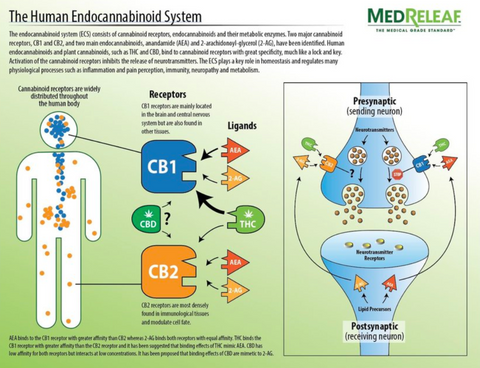
Endocannabinoid System (ECS): Everything You Need To Know
Share
Executive Summary:
The endocannabinoid system is not as well known as other body systems. Find out what it is, how it interacts with other systems in your body, and why it’s so important. We’ll also see how phytocannabinoids such as CBD and CBG interact with the endocannabinoid system.
We All Have an Endocannabinoid System
All humans and animals have something in common - the endocannabinoid system, or ECS. This is a physiological system in the body, like the cardiovascular system, the reproductive system, the metabolic system, etc. Because the endocannabinoid system has the word “cannabinoid” in it, and due to a history of cannabis being illegal, this physiological system is rarely included in Anatomy & Physiology courses in medical, nursing, and pharmacy educational programs. Yet it exists, and you should know about it!
The Master Regulatory System

The ECS is the master regulatory system of all of the other physiological systems in the body. It ensures that all systems are working together to maintain homeostasis or “balance”. No matter what stressors affect the inside or outside of the body, the ECS is there to direct traffic and ensure that the body and mind rebalance.
“Relax - Eat - Sleep - Forget - Protect”
A good way to remember what the ECS manages is “Relax - Eat - Sleep - Forget - Protect.” This refers to relaxation and stress reduction; stimulating appetite; helping to sleep; forgetting traumatic memories; and the immune system’s ability to reduce inflammation and protect from disease.
The ECS also regulates…
- pain signaling to the central nervous system
- psychomotor behavior (mind-body coordination, like driving a car or throwing a ball)
- memory
- temperature
- appetite
As mentioned above, the ECS regulates all of the other physiological systems, including the immune system. It also manages energy balance, which includes appetite, food intake, and sugar metabolism.
Read more: Expert Series: What is CBG (Cannabigerol)?
Cannabinoid Receptors
The ECS is composed of two types of receptors (cannabinoid receptors, called CB1 and CB2), endocannabinoids (endo = created within the body), and enzymes that help to create, break down, or transport these endocannabinoids as needed.
Cannabinoid receptors bind to incoming endocannabinoids and phytocannabinoids (like a lock and key) and then change their outgoing signals accordingly based on what is needed to maintain homeostasis.
CB1 receptors are densely located in the brain and central nervous system, and they are also found in the lungs, arteries and veins, muscles, gastrointestinal tract, and reproductive system.
CB2 receptors are found in the bones, in every type of skin cell, and in the spleen. They help to manage inflammation and immunity.
Both CB1 and CB2 receptors are found throughout the bone marrow, vascular system, immune system, and in the liver and pancreas.
Read more: A Look At The Period Hormone Chart
Endocannabinoids
Endocannabinoids are signaling molecules that are made within the body and attach themselves to cannabinoid receptors. The two that we know the most about are called anandamide and 2-arachidonoylglycerol, or 2-AG. You can see in the image below that anandamide and THC are somewhat similar in shape.
Anandamide is also known as “the bliss molecule.” It modulates pain, anxiety, learning, and memory, and it also helps to regulate appetite, pleasure, and motivation.
2-AG regulates so many aspects of the mind and body functions. It modulates body temperature, stress response, anxiety, and addiction and reward behaviors. It protects the nerves and nervous system from harm, and it affects how the nervous system functions. It also directs the development of the embryo in the uterus.
2-AG helps to maintain the cardiovascular system and it manages inflammation and the sensation of pain, including period pain. It modulates learning and memory, coordinates body movement, and regulates food intake and energy metabolism.
In short - almost everything we need to grow and function physically and mentally is regulated by these two endocannabinoids!

Phytocannabinoids
Phytocannabinoids (phyto = plant) from the Cannabis sativa plant also interact with the CB receptors. There are over 150 phytocannabinoids found in the cannabis plant, and they either fit into or block the cannabinoid receptors. They can also affect how the receptors interact with endocannabinoids or other chemicals in the body. Phytocannabinoids include THC, CBD, and CBG.
Many people turn to phytocannabinoids to assist with maintaining mental and physical balance. Trauma, chronic stress, chronic pain, poor nutrition, long-term sleep disruptions, and other stressors can cause an endocannabinoid deficiency syndrome in which the ECS is unable to properly regulate homeostasis. Cannabis may help regain and maintain the balance that the depleted endocannabinoids are unable to manage.
The ECS is intimately related to the actions of the reproductive system. The ECS influences hormones, which influence how the ECS functions. ECS deficiencies are thought to contribute to health conditions such as endometriosis, PMS, menstrual pain, and menopause symptoms. These health conditions are chronically under-researched and more investigation is needed. Stay tuned for our next Aima post in this series, in which we dive into the connections between the menstrual cycle and the endocannabinoid system.
References
Brents L. K. (2016). Marijuana, the Endocannabinoid System and the Female Reproductive System. The Yale journal of biology and medicine, 89(2), 175–191.
Clark, C. S. (2021). Cannabis: A handbook for nurses. Wolters Kluwer.
Lu, H. C., & Mackie, K. (2016). An Introduction to the Endogenous Cannabinoid System. Biological psychiatry, 79(7), 516–525. https://doi.org/10.1016/j.biopsych.2015.07.028
McPartland, J. M., Guy, G. W., & Di Marzo, V. (2014). Care and feeding of the endocannabinoid system: a systematic review of potential clinical interventions that upregulate the endocannabinoid system. PloS one, 9(3), e89566.
Editor: Lanna Last & Thomas Sauls
Scientifically Reviewed By: Mali Meibod
